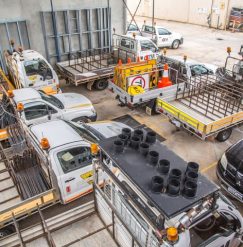Traffic management for commercial and industrial sites

Commercial and industrial sites are road authorities for their internal private road network.
They have a duty of care in the discharge of the function and responsibilities as a road authority. Where the section of their site is open to the general public there is a need to be in general compliance to the standards in construction, signage and delineation delivered in the public road network.
Traffic management of the site is divided between the section where the general public has unrestricted access and the section where, for operational safety reasons, there is restricted access to authorised personnel only.
The section with restricted access relies on traffic engineering aligned with the Hierarchy of Hazard Control Framework. In the restricted access area, whilst the site occupier (road authority) has more control, the traffic management task can also be more challenging due to the need to manage interactions between light vehicles, heavy vehicles, mobile plant (forklifts, skid steers, loaders (wheeled and tracked), site-only dump trucks (rigid and articulated), internal transfer vehicles and water tankers), pedestrians and sometimes cyclists (some large industrial sites use bicycles as a mode of transport within site).
Hierarchy of Hazard Control Framework consists of the following: control elements, brief description and effectiveness. This concept is expanded in the following table.
This is best illustrated in a recent case study.
QTM was engaged by a commercial site owner via its managing agent to undertake traffic investigations and provide possible solutions to an ongoing traffic management issue.
One part of the large commercial estate was repurposed into a service centre by a public sector tenant. The change of use triggered a change in the traffic generation and movement patterns at this quadrant of the site. The service centre is accessed via two approaches:
- Passing through a bulky goods store and its car parking area.
- Passing through the loading / pick up bay of the bulky goods store and the loading bay of a pool supply shop.
In the second approach, the investigation identified the lack of delineation between the loading area, pedestrian path and vehicle movement path. In order to better manage the road space of approach number two, the proposed solution was to delineate the loading area, allow for a truck queuing area to unload, a pedestrian path linking into the existing path network on site, one-way vehicle movement and separate the car parking area from the loading area by bollards, kerbing and a speed hump.
Inputs were sought from the occupiers and their staff on the possible configuration of the revised road way layout. A draft sketch based on the inputs was prepared and circulated for feedback and consultation from the relevant stakeholders.
With general consensus reached, the plan was implemented with improved clarity for loading, pedestrian movement and vehicle circulation.
| Hazard Control | Brief Description | Measures | Effectiveness |
| Elimination | Design the hazard out | Design or redesign of the site | Most Effective |
| Substitution | Using something else (that is less hazardous) | Alternate travel path. | |
| Engineering | Isolate the hazard and / or guard / warn against it |
|
|
| Administration | Training, revised method of work and work scheduling to minimise the hazard (s) |
|
Least Effective |
| Personal Protective Equipment (PPE) | Last resort in managing the hazards. | Use of PPE in helmets, hearing, googles, gloves safety boots and high visibility clothing |
